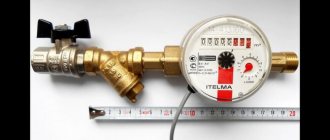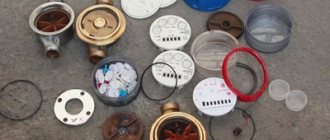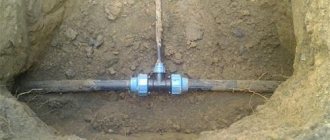In old houses, failure of the water supply system is a common occurrence. And installing an internal pipeline from modern materials or purchasing new plumbing fixtures does not solve the problem.
Only a complete replacement of the water supply risers in the apartment helps. If you have already encountered a similar problem and don’t know where to start, we will help you figure it out. The article will discuss what requirements should be observed when replacing risers, what stages the installation involves connecting the system and what materials will be needed for this.
Areas of responsibility
- By whom and at whose expense is the repair or replacement of water supply pipes in the apartment carried out?
The liners are the personal property of the homeowner, while the risers are the common property of the residents of the house. The boundary of the areas of responsibility passes through the connection in front of the tap or valve at the outlet from the riser.
If the tap or supply line is faulty, all repair work is carried out by the apartment owner at his own expense; Leaks and other faults in the riser are eliminated by the management company.
The boundary of the areas of responsibility runs along the connection of the cranes to the branches from the riser
What you need for DIY repairs
Before replacing a cast-iron sewer riser in an apartment with your own hands, you must obtain permission from the supervisory organization. Most often this happens if a person changes part of the structure only in his apartment. If everything is arranged as expected, you need to prepare the necessary tools:
- A large grinder with a cutting disc for metal, as well as a grinding wheel.
- A hammer drill with a concrete shovel and drills of different diameters.
- Hammer, chisel, pry bar or small crowbar.
- Construction level from 50 cm long.
As for materials, the set may differ, but the following list is most often used:
- Plastic pipes with a diameter of 110 mm of suitable length.
- Tee with the required number of bends.
- Adapter from PVC pipe to cast iron.
- Compensator coupling.
- Sealant for additional protection of connections.
- Fastening clamps equipped with a hairpin screw of suitable length and a plastic dowel.
Important!
Before starting work, it is necessary to agree with the neighbors above so that they do not use the sewer and do not turn on the water (it is better to turn it off altogether).
Executor
- Where to go if there is a problem with the water supply system?
For minor leaks and other malfunctions that are not related to the threat of flooding of your and neighboring apartments, contact the maintenance service of the service organization. If the apartment is flooded with water (even during the working hours of the maintenance department), it makes sense to call the emergency service (the same service organization or the city one).
A nuance: in the vast majority of cases, the emergency alarm does not eliminate the malfunction, but shuts off the water to a riser or a group of risers to eliminate the leak. Restoration of the pipeline will be carried out by the maintenance service during working hours.
The emergency service turns off the water and transfers the request to current repairs.
- Is it possible to contact a third-party commercial organization to troubleshoot water supply problems?
Of course.
But there are a couple of nuances here:
- In this case, no one will reimburse you for the cost of the work, even if we are talking about the common property of the residents of an apartment building;
- At the same time, you accept full responsibility for the quality of the work performed. For example, if after replacing a section of a riser using materials other than those provided for in the building design, it bursts and water floods the neighbors below, you may well be billed for repairs to the premises and damaged household appliances.
Consequences of apartment flooding
Involvement of third parties
It is better when such work is performed by a specialized organization.
In this case:
- an agreement is concluded
- deadlines are specified,
- cost of work,
- procedure for payment for work and access to premises,
- warranty obligations.
If the house is serviced by the management company, then it can conclude such an agreement to carry out the work, leaving control over it.
The owners can also make the calculation through the Managing Authority, but this will require a decision of the General Meeting or an advance payment to the settlement account of the Managing Authority before the start of work.
You can select a contractor via the Internet or advertisements in print publications. Before concluding an agreement, it is necessary to check the details and registration of the company with the tax authorities.
Important! It is better to make advance payment by bank transfer. The final calculation must be completed after all work has been completed and the water supply system has been tested.
What documents will be required to work with a contractor?
Apartment owners must confirm their right to the premises. To do this, it is enough to show the original certificate of registration of ownership and your passport. There is no need to submit any copies, much less original documents. The contract only contains the certificate number and the date of its issue.
If the house is serviced by the building authority, then approval of the work and access to the basement will be required. This can be done by a simple written request, both on behalf of the owner and the contractor, with reference to the concluded agreement.
Service life
- After what time should water supply pipes be replaced?
The service life of engineering equipment for residential buildings can be found in departmental standards VSN 58-88 R:
- Cold water supply pipelines (bottlings, connections and risers) made of non-galvanized steel pipes last 15 years;
Typical condition of black steel pipe risers
- Galvanized cold water pipelines are more durable - up to 30 years;
- Service standards for hot water pipelines in a building with a closed heating system (that is, with heating of cold water in heat exchangers and boilers) are 10 years for black steel and 20 years for galvanized steel;
- The same pipes in houses with open heating supply (when hot water is taken from the heating network) last 15 and 30 years, respectively.
A caveat: for galvanized pipes, the actual service life corresponds to the standard only if they are installed on threaded connections. When welding, the anti-corrosion coating inevitably burns out (simply because steel melts at 1400°C, and zinc evaporates at 900°C). The result is that the weld area has the protection of a black pipe and the durability to match.
Compare the melting points of steel and zinc
In practice, the decision to completely replace the utility network is made taking into account several factors:
- Its actual condition. The author has more than once or twice encountered galvanized risers and liners, which after 5-7 decades of service could boast of being in new condition and absolutely did not need to be replaced;
Galvanized risers in Stalinka are in excellent condition even 70 years after its construction
- Financing;
- Residents' activities. Alas, the most effective way to speed up the replacement of pipes remains a systematic reminder of the existing problem.
Who changes risers in an apartment building, procedure
Link: Article 161 of the Housing Code of the Russian Federation There have been situations when housing companies told residents that “there is no money” and offered the option of “chips in” for repairs - under no circumstances start collecting money, but go complain to the housing inspectorate! In some cases, you can seek help from the Housing and Communal Services Reform Assistance Fund.
One of the effective methods to force the management company to fulfill its obligations is to file a claim in court, in which to set out your demands. The fact that there are debtors cannot be a basis for the management company to refuse to perform its direct duties! To perform plumbing work, special knowledge and skills are required. If you live in a private house, then all responsibility for its maintenance and timely repairs lies entirely with you.
How everything works
Let's figure out how water supply risers function in an apartment building.
Pressure
- What should be the pressure in the water supply?
According to SP 30.13330.2016, the water supply to detached buildings should operate with a pressure of no more than 4.5 kgf/cm2 (6 kgf/cm2 if the house is built in an existing multi-storey building). The lower threshold of permissible pressure in the latest edition of the set of rules is not limited; in practice, it can be considered equal to the pressure at which household and sanitary appliances remain operational (0.3 kgf/cm2).
Atmor Basic turns on heating at a pressure of at least 0.3 atmospheres
As is customary, there is a nuance: if we are discussing the water supply of a multi-storey building, the riser may well have a height of more than 45 meters (which in buildings with a ceiling height of 2.7 meters, taking into account the thickness of the floors, corresponds to 15 floors). At this height, water will either be absent on the upper floors, or supplied to the lower floors with a pressure exceeding the standard.
Reference: 1 kgf/cm2 of excess pressure raises water to a height of 10 meters.
One atmosphere corresponds to 10 meters of water pressure
This problem can be solved in several ways:
- Installation of intermediate pumps on the middle floors;
Intermediate pumping on the technical floor of a high-rise building
- Separate water supply to the lower and upper floors: the upper floors are led by their own group of risers with increased pressure from the pumping station;
- Finally, the pressure on the lower floors can be limited by installing control valves - pressure reducers - at the entrances to apartments. This is precisely the decision prescribed by the notorious SP 30.13330.2016.
Gearboxes at the DHW and cold water inlets into the apartment
Circulation
- What is the layout of water supply risers in an apartment building? Are they related?
In cold water supply, the vertical water distribution becomes a dead-end: the riser ends with the supply of the upper floor. Cold water filling, however, can be circular: the loop solves the problem of pressure loss at the peaks of water intake and ensures the effective operation of the fire extinguishing system in buildings with fire-fighting water supply.
Captain Obviousness suggests: from a practical point of view, this means that to turn off the cold water riser, it is enough to turn off the valve or tap on it. Usually it is located in the technical basement or technical floor, at the connection of the riser to the bottling.
Disabling and resetting the cold water riser
For hot water supply in buildings built before the early 80s, the same dead-end wiring is used. But in most newer buildings, the hot water supply system is already circulating: water continuously moves through paired fillers and risers, equipped with ring jumpers on the upper floors or in the attic.
The presence of two hot water dispensers gives rise to the circulation system
Why is this necessary?
- Circulating hot water supply ensures the standard water temperature (according to SP 30.13330.2016, 60-65°C) even with a significant distance between the water collection point and the heating point or other water heater;
- Another advantage is the almost instantaneous supply of water at the required temperature. To heat it, you need to drain through the mixer only the water that is in the apartment’s water supply. For comparison, in a house with a dead-end hot water supply system, after a long absence of water supply (for example, in the morning), you have to drain the contents of the inlet, riser and bottling, which sometimes takes several minutes and leads to unreasonably high water consumption;
In a dead-end system, water needs to be drained for a long time before it heats up.
- Finally, the circulation of hot water gives hydronic heated towel rails the ability to operate around the clock. In a dead-end DHW system, they heat up only when water is drawn.
The dryer connected to the hot water supply heats up only during water draw-off
A loop can combine from 2 to 7 risers. Each of them is equipped with shut-off valves at the bottling connection and in the apartment on the top floor. If you do not have access to the upper apartment through the riser, to turn off the hot water you have to reset the entire looped group.
Hint: if there are two hot water risers in an apartment, they are usually connected to each other. If in a house with a hot water circulation system there is one riser passing through the apartment, then, as a rule, all the risers in the entrance are looped.
Heated towel rails
- Where and how should the heated towel rail be connected when replacing the riser with your own hands?
The instructions can be found in the same SP 30.13330.2016: the device can be connected to a hot water circulation riser provided that shut-off valves and a bypass are installed. This scheme allows you to turn off the heating of the heated towel rail in the summer heat without disrupting the circulation in the group of risers.
Bypass and taps for connecting the heated towel rail to the hot water riser
The nuances of connecting to a water supply network
Where the junction of the vertical water supply riser with the apartment wiring will be located, install a tee with parameters 32/20/32 or 25/20/25 (depending on the pipe diameters used). To make it easier to install this tee, liquid soap is applied to its end. Parts of the structure are soldered. If you want to install a heated towel rail in the bathroom, then 2 more tees are installed on the riser.
Keep in mind that it is best to connect tees by soldering rather than using couplings.
After the shut-off valve is installed, it is worth checking for leaks. If everything is fine, then the connected elements are attached to the wall. For this purpose, marks should already be made on the wall for drilling holes for the clips. The distance between the fasteners should be approximately 1–1.5 m.
You can run water through the riser at least an hour after the pipes have been joined. It is also worth remembering the need to ensure proper waterproofing and sound insulation. For this purpose, the places where the pipes cross the floors must be concreted throughout the entire thickness. However, finishing work (including this one) should be carried out only after you have checked the strength of the structure.
Materials
- What materials can be used to replace a section of the water supply system (riser or liner)?
For domestic hot water, the answer depends on the heating system in your home.
If it is open (that is, hot water flows to your faucet directly from the heating main), we strongly recommend choosing metal pipes:
| Image | Description |
| According to GOST 3262-75, water and gas pipes (including those with zinc coating) undergo hydraulic tests with a pressure of 25 (for reinforced pipes - 32) kgf/cm2. Mounted on threaded or (less commonly) compression connections. In practice, they last at least 30-50 years. |
| With a wall thickness of 0.8-1 mm, they have a tensile strength of up to 240 kgf/cm2. They are connected by socket soldering, as well as deformable crimp fittings and compression fittings. They have limited flexibility and unlimited service life. |
| A corrugated stainless steel pipe has a wall thickness of only 0.3 mm, but its tensile strength (up to 210 kgf/cm2) is not much inferior to copper. The bending radius of the pipe is equal to its diameter, which greatly simplifies installation and allows you to get by with a minimum number of fittings. Connections are compression, with silicone seal. The service life of the pipes themselves is not limited by the manufacturer, but after thirty years the owner will have to replace the silicone rings in all fittings. |
In cold water and hot water supply systems with water supplied from boilers, geysers, heat exchangers of a heating point, etc. You can use lightweight, durable and inexpensive polymer and metal-polymer pipes (PPR, PERT, PEX, PERT/AL/PERT, PEX/AL/PEX).
Preparation of hot water in a house with a closed heating system
Connections and risers made of PPR pipes
Why shouldn’t they be installed in a centralized hot water supply system with water supplied from the elevator unit?
There are actually only two reasons:
- The possibility of water hammer occurring in such a system;
- Non-zero probability of a significant (up to the maximum possible 150°C) excess of the standard water temperature.
In cold weather, the supply temperature of the heating main reaches +150 degrees
If metal pipes tolerate overheating and pressure surges well (of course, within reasonable limits), then for polymer pipes deviations from the operating conditions recommended by the manufacturer mean a significant reduction in service life or even instantaneous destruction.
The influence of operating conditions on the durability of polypropylene
Who changes risers in an apartment building, procedure
Link: Article 161 of the Housing Code of the Russian Federation There have been situations when housing companies told residents that “there is no money” and offered the option of “chips in” for repairs - under no circumstances start collecting money, but go complain to the housing inspectorate! In some cases, you can seek help from the Housing and Communal Services Reform Assistance Fund.
One of the effective methods to force the management company to fulfill its obligations is to file a claim in court, in which to set out your demands. The fact that there are debtors cannot be a basis for the management company to refuse to perform its direct duties! To perform plumbing work, special knowledge and skills are required. If you live in a private house, then all responsibility for its maintenance and timely repairs lies entirely with you.
Practical advice
- Why do fistulas occur on pipes and how to eliminate them?
A fistula indicates through-corrosion of the water supply system. Fistulas most often appear on welds (at a pipe connection or a longitudinal seam: all water and gas pipes according to GOST 3262-75 are produced by welding a flat piece).
Fistula on a steel heated towel rail
A single fistula can be eliminated without welding by installing a bandage made of a rubber gasket (for example, for a crane box) and a clamp or knitting wire. If there are a large number of fistulas, the problem area of the liner or riser must be replaced.
Bandage from a collar
- Is it necessary to change the riser in the ceiling?
If there is at least some opportunity for this, it is necessary. Steel pipes rust most quickly inside the cement-sand seal of the ceiling.
Correct replacement of risers: pipes are passed through the ceiling
- How to make the transition from a steel pipe to a fitting for connecting metal-plastic or polypropylene?
This can be done in three ways:
- Weld a threaded pipe to the cut riser;
- By cutting the thread manually, using a die or die;
To install the adapter on the steel riser, a thread is cut
- By installing a compression fitting adapter on a smooth pipe.
Installing a compression fitting on a smooth steel pipe
Important: in the latter case, the end of the pipe must be thoroughly cleaned of paint and rust.
- Why do you need reinforcement of polypropylene pipes and is it worth buying reinforced pipes to replace a riser or liner?
Reinforcement with fiber or foil increases the pipe's resistance to hydrostatic pressure and, more importantly, reduces its elongation with increasing temperature. Heating by 50 degrees causes each meter of unreinforced pipe to become 7 mm longer. Fiber reduces elongation to 3 mm, foil to 1.5.
Aluminum pipe reinforcement
For comparison: a steel pipe under the described conditions elongates by 0.5 mm.
Reinforcement is preferably done in hot water. You can safely install unreinforced pipes on cold water pipes.
The aluminum foil must be stripped at the end of the pipe before welding it to the fitting
- Why do plastic hot water risers become deformed and how to avoid this?
Hot water riser bend
The reason is the notorious elongation of pipes when they are heated. The problem is solved by installing ring or U-shaped compensation bends; in this case, the clamps closest to the compensator should provide sliding fastening of the pipe.
Risers with ring expansion joints
- Why do connections on metal-plastic leak?
Location of the leak - connection between the fitting and the pipe
Exclusively due to gross errors during the installation of compression and (less often) press fitting connections. The pipe must be cut only with a pipe cutter and must be calibrated. In addition, the internal chamfer must be removed from its end.
Correct execution of the operation: the pipe is cut with a pipe cutter and calibrated
Tip: Many calibrators are equipped with knives that chamfer during calibration.
Valtec Universal Calibrator
If a metal-plastic pipe is cut with a hacksaw or grinder and retains the ovality acquired when coiled, the following happens when assembling the joint:
- The uneven end of the pipe, when put on the fitting fitting, pulls out the elastic sealing rings from the grooves and moves the elastic sealing rings towards the fluoroplastic washer;
The photo clearly shows the o-ring on the fitting
- Instead of a sealant, the pipe is crimped directly onto the brass fitting;
- When heated, the fitting expands, and the increased pressure squeezes the softened plastic of the inner shell of the pipe out of the space between the fitting and the aluminum core;
- When cooled, a leak occurs between the fitting and the core.
It’s interesting: in cold water, metal-plastic forgives installation errors due to its stable temperature conditions and the absence of expansion-compression cycles.
Tips for those who want to replace the sewer riser along with the water supply riser
Changing the sewer system pipes in an apartment requires calculations that are somewhat more complicated. Note that dismantling in this case is not easy. However, the assembly of new structures is still faster than pipes with cold/hot water. After all, the drain pipes are connected through a socket using a sealing ring, so there are no particular difficulties in this operation - except that the work itself will be somewhat dirtier than when replacing water pipes or heating systems.
Replacing sewer pipes in an apartment consists of three steps:
- Initially, you will need to update the siphon elements that are located under the sinks. Next, calculations are performed to determine the slope of the pipes that connect the riser and siphon. Slope refers to the difference in height above the floor between the entrance of the pipe and its exit. The entrance is located under the siphon itself, the outlet part is on the tee of the fan riser. This height difference is directly determined by the length of the pipe.
As a rule, a pipe with a diameter of 5 cm is laid with a slope of 2.5–3.5 cm per linear meter. After determining this value, it will be necessary to project the dimensions onto the surface, which will serve as a support for the planned sewer pipe. To do this, draw the position of the branch directly on the wall. Next, you can begin dismantling the old drain pipes.
- You will need to remove the fan riser, having first blocked it. When removing, a pneumatic plug is inserted into the collapsible end of the riser revision; it will act as a plug from the neighboring drains. After this, you need to extremely carefully caulk the central tee - it is responsible for connecting all the drain pipes in the apartment. After this, they get rid of the old pipes; this operation does not require any special actions. If these are cast iron products, they are simply hit with a hammer and the broken parts are thrown away.
- Then you need to assemble it. First, a polyvinyl chloride pipe is installed. It is responsible for connecting the toilet flush and a tee with a diameter of 10 cm (cast iron). Next, drain pipes leading from the sinks and bathtub are connected to the tee. Their diameter is 5 cm. The operation is simple - the smooth end of the pipe is connected to the socket.
After this, the revision is freed from the plug, and the riser itself is hermetically sealed by simply screwing on the caps. At this point, the replacement of sewer pipes is considered complete, and the new drainage system is ready for use.
Cooperating with is reliable and prestigious. The specialists working here are professionals of the highest level. operates throughout Moscow and the Moscow region.











